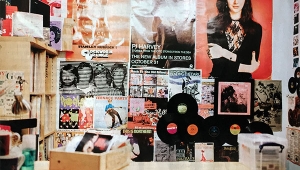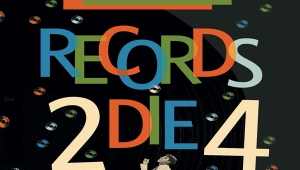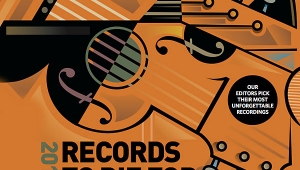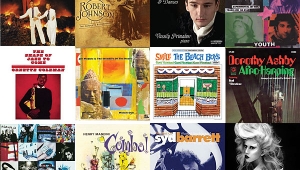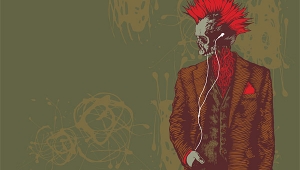| Columns Retired Columns & Blogs |
1999 Records To Die For Page 14
David Patrick Stearns
AUDRA McDONALD: Way Back to Paradise
Songs by Ricky Ian Gordon, Michael John LaChiusa, Adam Guettel, Jason Robert Brown, others
Audra McDonald, soprano; Orchestra conducted by Eric Stern
Nonesuch 79482-2 (CD). 1998. Tommy Krasker, prod.; Joel Moss, eng. DDD. TT: 49:41
Do you ever get the feeling that a recording company is reading your mind and giving you exactly what you want? That's the case here: Three-time Tony Award winner Audra McDonald has been overdue for a solo album just by virtue of her Dawn Upshaw-like voice and keen acting ability. But rather than just singing some standards, she's the first to anthologize a new generation of composers who promise to make Broadway smarter. Whether singing a paean to pregnancy in "Baby Moon" or a penetrating Monica Lewinsky-esque character study in "Mistress of the Senator," McDonald successfully sells often-difficult music that's full of adventurous key modulations and dramaturgy devoid of polite veneer.
CALVET QUARTET: Chamber Works by Debussy, Ravel, Schmitt, Caplet, Delannoy
Lys 298-299 (2 CDs). 1998. No prod. or eng. listed. ADD. TT: 2:09:33
Francophile collectors know about the Calvet Quartet mostly from their oft-published recording of the Fauré Piano Quartet with Robert Casadesus. This is one of four volumes published by the France-based Lys label, and it consists of revelatory performances of French repertoire recorded 1931-38. These may be the best-ever recordings of the Debussy and Ravel quartets, performed with a rock-solid precision uncharacteristic of French musicians and a total sense of comprehension. The slow movement of the Ravel has never seemed so intimate and confiding, the finale never so stricken with terror. The style is a bit old-fashioned, but the swooping portamentos that went out of style after World War II have never sounded so purposeful, even indispensable. The other Calvet volumes include nearly-as-great Schubert and Beethoven performances. Lys has iffy distribution in the US; pray that it gets better.
BARNEY KESSEL/RAY BROWN/SHELLY MANNE: Poll Winners Three!
Barney Kessel, electric guitar; Ray Brown, acoustic bass; Shelly Manne, drums
Contemporary S-7576 (LP), Fantasy/OJC OJCCD-692-2 (CD). 1959/1992. Lester Koenig, prod.; Roy DuNann, eng. AAA/AAD. TT: 39:10
These three instrumental giants were dubbed "The Poll Winners" for their perennial domination of the annual Down Beat, Playboy, and Metronome popularity contests back in the '50s. Inspired as they were by the work of such transitional figures as Lester Young, Coleman Hawkins, Jimmy Blanton, Oscar Pettiford, and Charlie Christian on one hand, and the likes of Charlie Parker and Dizzy Gillespie on the other, their collective work reflects their immense affection for the parameters of the American popular song, the swing era, and the breakthroughs of bebop. Of three period recordings and one 1976 reunion date, Poll Winners Three! remains the pick of the litter—a vividly recorded, rhythmically combustible trio date, and a real benchmark for modern jazz guitarists in the days preceding Wes Montgomery's reign.
PAT METHENY: Bright Size Life
Pat Metheny, electric 6- & 12-string guitars; Jaco Pastorius, fretless electric bass guitar; Bob Moses, drums
ECM 1073 (LP), 78118-210730-2 (CD). 1976. Manfred Eicher, prod.; Martin Wieland, eng. AAD. TT: 37:12
This recording, Metheny's maiden voyage as a leader, is a personal benchmark for me as a writer and listener. A snooty dismissal of this recording in Down Beat inspired me to write my own take on what I thought was among the finest guitar trios in jazz history, and led to my first published piece in the Village Voice.
RENEE ROSNES: As We Are Now
Renee Rosnes, piano; Chris Potter, tenor & soprano sax; Christian McBride, bass; Jack DeJohnette, drums
Blue Note 7 56810 2 (CD). 1998. Don Sickler, prod.; Renee Rosnes, asst. prod.; Rudy Van Gelder, eng. DDD. TT: 60:09
I raved about this album in these pages early last year, but it's so good it deserves another shout. Rosnes is one of acoustic jazz's finest yet least recognized artists, a player and composer who stretches boundaries while never relinquishing her admiration for jazz's past. This album is far-reaching yet accessible. On it—in the company of two rhythm masters and her sometime saxophonist, the intrepid, searching Potter—Rosnes delivers a series of grand moments. Among them: the probing-then-sweet "Abstraction Blue," a platform for Rosnes' vital, tuneful piano artistry; the lyrical-then-crackling "Land of Five Rivers"; the driving "Black Holes," in which Potter stomps over a one-chord vamp; and the '90s hard bop of "Bulldog's Chicken Run." (XXI-6)
JOE HENDERSON: Page One
Joe Henderson, tenor sax; Kenny Dorham, trumpet; McCoy Tyner, piano; Butch Warren, bass; Pete LaRoca, drums
Blue Note 7 84140 2 (CD). 1963/1988. Alfred Lion, prod.; Rudy Van Gelder, eng. AAD. TT: 42:17
Page One is easily as perfect an album as Miles Davis' Kind of Blue. This wonderfully conceived and performed debut album by the man who has become the tenor saxophonist of the day rightly reached near-legendary status when first released, and there are many reasons. The tunes—all originals by Henderson or Dorham—are brilliant and memorable. There's the lovely "La Mesha," the complex "Jinrikisha," and the now-classic "Blue Bossa" (surely played as often as "So What"), plus three superb others. The playing is exquisite: the leader's compelling, intelligent mix of warmth and bite, Dorham's fuzzy sound and hip ideas, and Tyner's luminous, singing tones. This music is still fresh three and a half decades after it was made. How often can you make a statement like that?
AUDRA McDONALD: Way Back to Paradise
Songs by Ricky Ian Gordon, Michael John LaChiusa, Adam Guettel, Jason Robert Brown, others
Audra McDonald, soprano; Orchestra conducted by Eric Stern
Nonesuch 79482-2 (CD). 1998. Tommy Krasker, prod.; Joel Moss, eng. DDD. TT: 49:41
Do you ever get the feeling that a recording company is reading your mind and giving you exactly what you want? That's the case here: Three-time Tony Award winner Audra McDonald has been overdue for a solo album just by virtue of her Dawn Upshaw-like voice and keen acting ability. But rather than just singing some standards, she's the first to anthologize a new generation of composers who promise to make Broadway smarter. Whether singing a paean to pregnancy in "Baby Moon" or a penetrating Monica Lewinsky-esque character study in "Mistress of the Senator," McDonald successfully sells often-difficult music that's full of adventurous key modulations and dramaturgy devoid of polite veneer.
CALVET QUARTET: Chamber Works by Debussy, Ravel, Schmitt, Caplet, Delannoy
Lys 298-299 (2 CDs). 1998. No prod. or eng. listed. ADD. TT: 2:09:33
Francophile collectors know about the Calvet Quartet mostly from their oft-published recording of the Fauré Piano Quartet with Robert Casadesus. This is one of four volumes published by the France-based Lys label, and it consists of revelatory performances of French repertoire recorded 1931-38. These may be the best-ever recordings of the Debussy and Ravel quartets, performed with a rock-solid precision uncharacteristic of French musicians and a total sense of comprehension. The slow movement of the Ravel has never seemed so intimate and confiding, the finale never so stricken with terror. The style is a bit old-fashioned, but the swooping portamentos that went out of style after World War II have never sounded so purposeful, even indispensable. The other Calvet volumes include nearly-as-great Schubert and Beethoven performances. Lys has iffy distribution in the US; pray that it gets better.
![]()
Chip Stern
BARNEY KESSEL/RAY BROWN/SHELLY MANNE: Poll Winners Three!
Barney Kessel, electric guitar; Ray Brown, acoustic bass; Shelly Manne, drums
Contemporary S-7576 (LP), Fantasy/OJC OJCCD-692-2 (CD). 1959/1992. Lester Koenig, prod.; Roy DuNann, eng. AAA/AAD. TT: 39:10
These three instrumental giants were dubbed "The Poll Winners" for their perennial domination of the annual Down Beat, Playboy, and Metronome popularity contests back in the '50s. Inspired as they were by the work of such transitional figures as Lester Young, Coleman Hawkins, Jimmy Blanton, Oscar Pettiford, and Charlie Christian on one hand, and the likes of Charlie Parker and Dizzy Gillespie on the other, their collective work reflects their immense affection for the parameters of the American popular song, the swing era, and the breakthroughs of bebop. Of three period recordings and one 1976 reunion date, Poll Winners Three! remains the pick of the litter—a vividly recorded, rhythmically combustible trio date, and a real benchmark for modern jazz guitarists in the days preceding Wes Montgomery's reign.
Brown and Manne, one of the all-time great rhythm teams (listen to their inspirational work behind Sonny Rollins on that other Contemporary classic, Way Out West), eschew rote accompaniment in favor of continual dialog. Kind of rough around the edges but deeply imbued with the southwestern blues spirit of Christian, Kessel doesn't possess Johnny Smith's commanding patrician elegance, nor does he have the fiery chops of Tal Farlow and Jimmy Raney. But he swings like a MF, mixes chords and single lines in a sly, coherent manner, and has a sweet amplified sound.
Recorded with the taut, dry dynamics that are a hallmark of the Contemporary sound, the bass and drums have great presence: they're resoundingly fat, live, and vibrant. And from the spooky bluesiness of "Minor Mystery" and the rhythmic complexity of "Crisis" to the elemental swing of "Soft Winds," the collective mirth on the rhythm changes to "It's All Right With Me" and "I Hear Music," this is an example of group interplay at its most witty and commanding, from an era when the terms "jazz" and "fun" were not mutually exclusive.
PAT METHENY: Bright Size Life
Pat Metheny, electric 6- & 12-string guitars; Jaco Pastorius, fretless electric bass guitar; Bob Moses, drums
ECM 1073 (LP), 78118-210730-2 (CD). 1976. Manfred Eicher, prod.; Martin Wieland, eng. AAD. TT: 37:12
This recording, Metheny's maiden voyage as a leader, is a personal benchmark for me as a writer and listener. A snooty dismissal of this recording in Down Beat inspired me to write my own take on what I thought was among the finest guitar trios in jazz history, and led to my first published piece in the Village Voice.
Often overlooked by Metheny's core audience, Bright Size Life achieves a perfect architectonic balance between form and freedom. Driven along by drummer Bob Moses' splashy, roiling energy, Metheny and electric-bass innovator Jaco Pastorius engage in a contrapuntal dialog that is boldly telepathic and furiously emotive on the open-ended swing of "Missouri Uncompromised," "Round Trip/Broadway Blues," and the eastern-flavored rhythm changes of "Unquity Road." The manner in which Pastorius suspends time and harmony, essays melodic rejoinders, and continually orchestrates fresh responses to Metheny's tart, twisting lines is simply miraculous. Metheny responds with a sensual, bell-like timbre and an intuitive brand of melodic freedom that is equal parts Jim Hall and Ornette Coleman.
On the title tune and "Omaha Celebration," Metheny achieves an easygoing, rocking gait and melodic flow that are pure Americana, while employing a curiously tuned Fender Electric 12-string guitar to achieve a mysterious, jangly texture on "Sirabhorn" and "Midwestern Night Dreams." On the latter, the guitarist displays his innate genius for creating sonic atmospherics, as his tolling chords set off Jaco's spectral bass lines and massive vocalized chords in stark relief against a huge, reverberant soundstage. I've been listening to this selection for 20 years, and it still sends chills down my spine.
![]()
Zan Stewart
RENEE ROSNES: As We Are Now
Renee Rosnes, piano; Chris Potter, tenor & soprano sax; Christian McBride, bass; Jack DeJohnette, drums
Blue Note 7 56810 2 (CD). 1998. Don Sickler, prod.; Renee Rosnes, asst. prod.; Rudy Van Gelder, eng. DDD. TT: 60:09
I raved about this album in these pages early last year, but it's so good it deserves another shout. Rosnes is one of acoustic jazz's finest yet least recognized artists, a player and composer who stretches boundaries while never relinquishing her admiration for jazz's past. This album is far-reaching yet accessible. On it—in the company of two rhythm masters and her sometime saxophonist, the intrepid, searching Potter—Rosnes delivers a series of grand moments. Among them: the probing-then-sweet "Abstraction Blue," a platform for Rosnes' vital, tuneful piano artistry; the lyrical-then-crackling "Land of Five Rivers"; the driving "Black Holes," in which Potter stomps over a one-chord vamp; and the '90s hard bop of "Bulldog's Chicken Run." (XXI-6)
JOE HENDERSON: Page One
Joe Henderson, tenor sax; Kenny Dorham, trumpet; McCoy Tyner, piano; Butch Warren, bass; Pete LaRoca, drums
Blue Note 7 84140 2 (CD). 1963/1988. Alfred Lion, prod.; Rudy Van Gelder, eng. AAD. TT: 42:17
Page One is easily as perfect an album as Miles Davis' Kind of Blue. This wonderfully conceived and performed debut album by the man who has become the tenor saxophonist of the day rightly reached near-legendary status when first released, and there are many reasons. The tunes—all originals by Henderson or Dorham—are brilliant and memorable. There's the lovely "La Mesha," the complex "Jinrikisha," and the now-classic "Blue Bossa" (surely played as often as "So What"), plus three superb others. The playing is exquisite: the leader's compelling, intelligent mix of warmth and bite, Dorham's fuzzy sound and hip ideas, and Tyner's luminous, singing tones. This music is still fresh three and a half decades after it was made. How often can you make a statement like that?
- Log in or register to post comments






